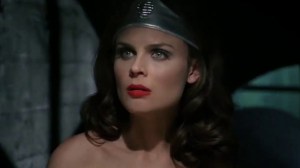
The selling points for Pearl #1 are primarily visceral. Michael Gaydos flexes almost every set of muscles in his artistic body in a range of sequences and styles. They tell a story that is pure noir with Bendis’ dialogue at the peak of its form. The aesthetics of this story are the best form of what they are, and it will surely delight fans of this longtime collaborative duo who co-created Alias and introduced readers to Jessica Jones. What remains unclear is how they will handle the central themes of this story, one that raises the objectification and commodification of women’s bodies without ever really addressing those topics. It is an arrangement that creates a compelling first issue, one that thrives in its artwork, plot, and action, but that leaves precarious questions dangling over the series as a whole like the Sword of Damocles.
Videos by ComicBook.com
It is worth addressing what makes this first issue captivating before arriving at the potentially oblivious treatment of its protagonist. Gaydos has an unmistakable style, one that regularly makes for some of the most striking covers in comics today. He also has substance to match and that’s much of what makes reading Pearl #1 irresistible in spite of any misgivings. His inks are clearly his throughout every page, but varied levels of detail and color palettes are utilized to vary elements of time and place. When engaged in long sequences of dialogue, Gaydoes provides a high level of texture and rich colors that encourage readers to linger on faces. It’s easy to take time with these conversations and feel as though you’re dawdling on the boardwalk or in a backroom with friends or new acquaintances. This provides a baseline for Pearl, one that is regularly disrupted.

Pearl, the lead character, is not just a tattoo artist, she’s also very good with a gun. When a fight begins it moves quickly. Gaydos drops colors from the scene and distills it into a more closely cropped set of essential moments. The resulting sequence is easy to follow and offers an effect close to that of a slow motion shot. When it is juxtaposed in the middle of a page, it takes the same amount of space temporally and makes the rapidity of actions all the more impressive. Gaydos tests other effects for other moments, like a flashback sequence, and they are all just as effective. It is impressive storytelling and makes Pearl #1 feel like a satisfying and varied read.
It is in that flashback sequence that readers are pushed to consider how active Pearl is in her own story though. Her skill with a gun is revealed to be something impressed on her by a father worried about boys having sex with his daughter. This moment is not simply a cliche, it follows a trend in which Pearl is told that she is an object to be used by others and acts primarily in response to these demands. She is given a tattoo by a man who decides she ought to have it, a job by a man who demands she take it, a relationship by a man who she just met. Much of her life and circumstances in Pearl #1 are thrust upon her and there’s no indication that this status has been thoroughly considered. While it is worth noting that this is a first issue and all of these instances could be providing a framework for response, it is a troubling framework and one that demands response. Pearl is a character with personality and skill, but she also lacks agency in the first issue of a comic that bears her name.

All of these concerns, ones that Pearl #1 provides no framework to alleviate, are what make the craftsmanship displayed by both Gaydos and Bendis so important. The pair are at the top of their form, individually and together. Taken purely as a modern noir tale and compelling piece of visual storytelling, Pearl #1 succeeds on all fronts. Stories cannot be read in a vacuum though and this issue dances drunkenly between careful framing and ill considered origin. While the skill of the storytellers involved is never in doubt, the ultimate value of Pearl leaves a big question mark for readers at the end of the first installment.
Published by DC Comics
On August 15, 2018
Written by Brian Michael Bendis
Art by Michael Gaydos
Letters by Joshua Reed








